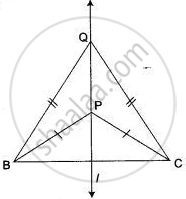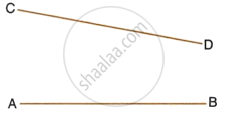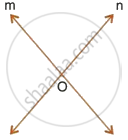Advertisements
Advertisements
प्रश्न
ΔPBC and ΔQBC are two isosceles triangles on the same base. Show that the line PQ is bisector of BC and is perpendicular to BC.
उत्तर
Given: ΔPBC and ΔQBC are two isosceles triangles on the same base BC.
To prove: Line PQ is the perpendicular bisector of BC.
Proof: In ΔPBC, PB = PC
Since, the locus of a point equidistant from B and C is the perpendicular bisector of 1 of the line segment BC
∴ P lies on 1
Similarly Q lies on 1
Therefore, PQ is the perpendicular bisector of BC.
Hence proved.
APPEARS IN
संबंधित प्रश्न
Construct a right angled triangle PQR, in which ∠Q = 90°, hypotenuse PR = 8 cm and QR = 4.5 cm. Draw bisector of angle PQR and let it meets PR at point T. Prove that T is equidistant from PQ and QR.
In the figure given below, find a point P on CD equidistant from points A and B.

Describe the locus for questions 1 to 13 given below:
1. The locus of a point at a distant 3 cm from a fixed point.
Describe the locus of the centre of a wheel of a bicycle going straight along a level road.
Describe the locus of a runner, running around a circular track and always keeping a distance of 1.5 m from the inner edge.
Describe the locus of points inside a circle and equidistant from two fixed points on the circumference of the circle.
Describe the locus of the centres of all circles passing through two fixed points.
In the given figure, obtain all the points equidistant from lines m and n; and 2.5 cm from O.

In a quadrilateral ABCD, if the perpendicular bisectors of AB and AD meet at P, then prove that BP = DP.
Find the locus of the centre of a circle of radius r touching externally a circle of radius R.
